New Orleans History: the One of a Kind Bellwether Baroness
The woman responsible for why New Orleans looks the way it does today.
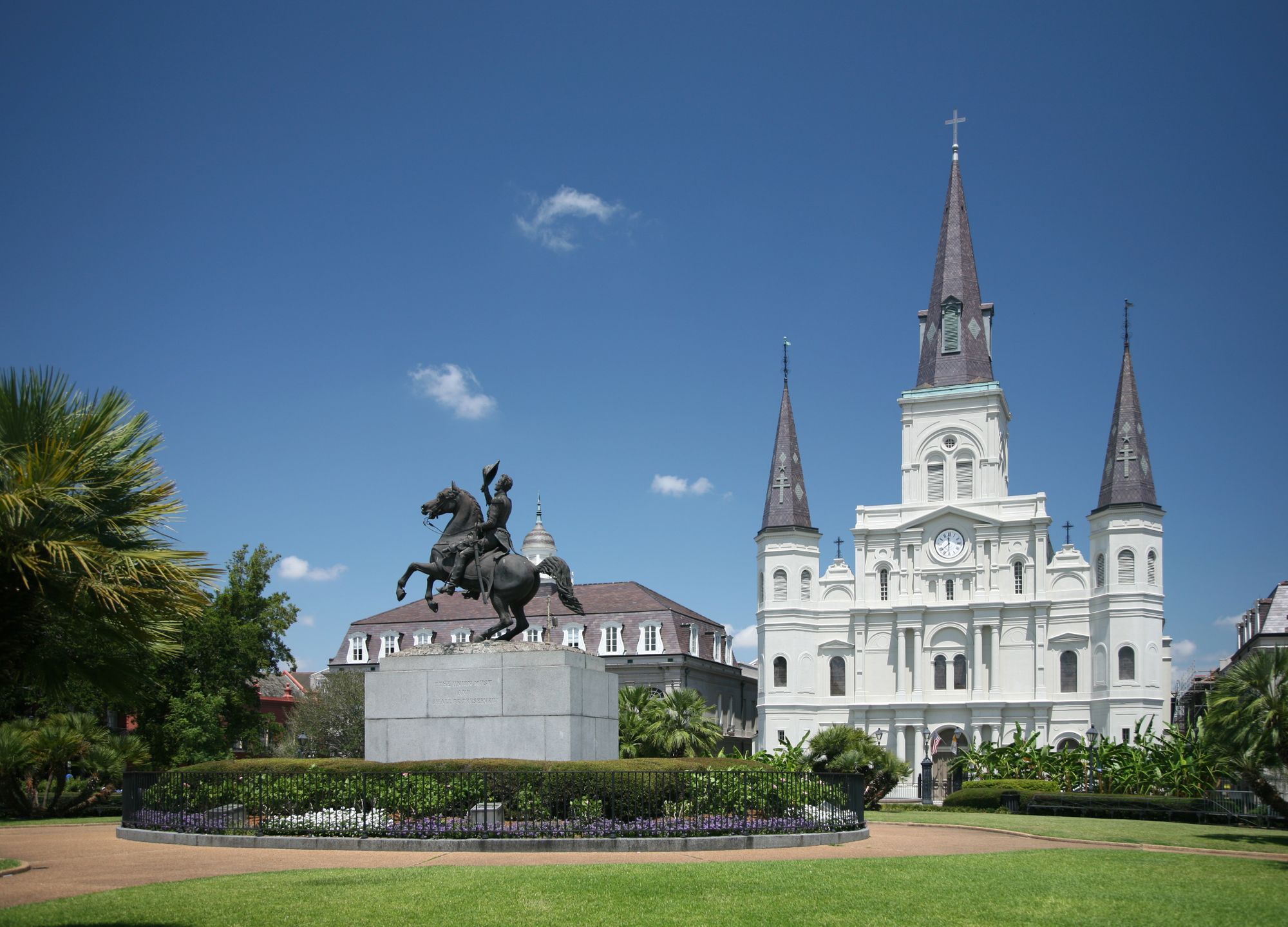
Warning for discussion of slavery, violence, and someone who dies by suicide.
It's currently Mardi Gras season so I thought it'd be fun to do a New Orleans based history lesson. Mind you part of what fueled this decision is me thinking people already know a lot about Mardi Gras and thus don't feel a need to hear me talking about things like what's a King Cake. If I'm wrong about that by all means let me know.
Anyway, some history! Let's talk about the person who is responsible for why New Orleans looks the way that it does.
By New Orleans I mean the French Quarter, which was the city of New Orleans back in the day. But still: I say the words New Orleans and odds are you aren't picturing the Central Business District. The first thing your mind probably goes to is a picture of Jackson Square flanked by those gorgeous buildings complete with cast iron galleries.
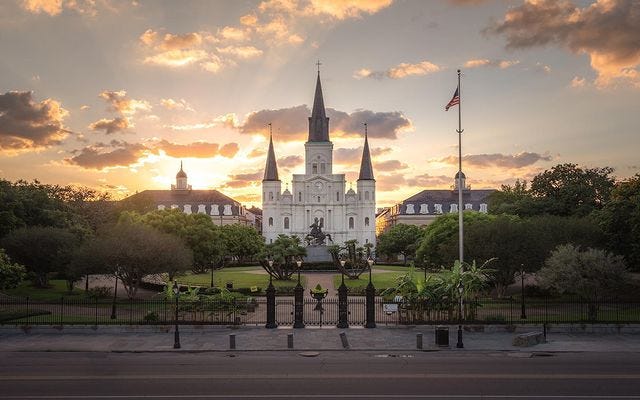
A post shared by Visit New Orleans (@visitneworleans)
That image, that very image, is thanks to one woman: Micaela Leonarda Antonia Almonester, Baroness de Pontalba.

Now before we dive too deep into a romanticized history hole, let's be very clear: New Orleans thrived on slavery. New Orleans was and is a port city. You know what the biggest imports and exports were prior to the Civil War? Enslaved humans. You know what the next biggest imports and exports were? The harvests from plantations, which were worked on by, oh yeah, enslaved humans.
So as much as I love the city we can never forget that it was a primary hub for the horror of slavery. Likewise any time you hear about a rich person in New Orleans there's no part of their money which wasn't somehow connected to this torture of human beings. It's just not possible. So we can't look at these glimpses of history as though one thing excuses another. Stories like this are for adding depth to what is already known, not for erasing horrific actions to elevate the people who benefited from them.
Hopefully that makes sense. My point is that everybody who knows about New Orleans knows about these buildings, however most people don't know where the buildings came from. I'm telling you this story to provide the information. I'm not saying the people I'm about to tell you about were good I'm saying they're interesting. Big difference.
All right, so! Set the wayback machine for the year 1795.
Micaela Leonarda Antonia Almonester was the daughter of Don Andrés Almonester and Louise de la Ronde. Her parents were from Europe but she was born while they lived in New Orleans.
Papa Almonester was known as a philanthropist due to how he gave money to various key creations in New Orleans, including the building of St Louis Cathedral, aka that church you see smack dab in the middle of every picture of Jackson Square that has ever been taken on Earth.
Now again, remember: Papa Almonester could do this because he was rich. He was rich because of slavery. We're not ignoring that part, we're just taking a moment to appreciate the irony of calling a guy benefiting from the torture of humans a "philanthropist."
(I have a WHOLE rant about slavery as it was viewed at the time in the various parts of what is now the US. Trust me we'll get there in a future newsletter. Though if you want previews you can try here and here.)
Anyway, point being that Papa Almonester was rich and heavily involved in real estate in New Orleans. Fast forward to when his daughter Micaela was of marriageable age and she's got some hefty sums of cash and real estate that she can lay claim to, including the buildings around what was then known as the Place d'Armes.
Mind you this was 1811 so marriageable age for Micaela was her being 15 years old. Also it meant that she was put into an arranged marriage with her cousin, Xavier Célestin Delfau de Pontalba.
Micaela’s new hubby was five years older than she was. His nickname was "Tin Tin." To all reports he was exactly like you'd picture a 20 year old male who willingly allowed people to call him "Tin Tin" to be, which is to say not the strongest of personalities.
After the wedding they moved to France and lived in a chateau owned by Tin Tin's family. They had five kids, four sons and a daughter. But things weren't great.
The problem came in as Tin Tin's dad, Baron Joseph Xavier Delfau de Pontalba, started interfering.
You see when he married Tin Tin off to Micaela ol' Joey* was doing it for Micaela's money. He started complaining pretty much from the start that Micaela's dowry was too small, even though it was the agreed upon amount of $40,000 and some jewelry which isn't bad shakes by today's money, let alone back then. But by Joey's reasoning, the dowry only represented one fourth of what Micaela inherited, so he was being cheated.
(* The Baron actually went by Xavier. He is an asshole, though, so I'm going to call him Joey because I feel pretty sure he would hate being called that.)
Joey, unlike his son, was strong of personality and also a supreme douchebag. Not content to whine about the dowry, he pushed for the rest of what both Micaela and her mother owned, even while Micaela's mother was still alive.
Joey forced Micaela to sign over power of attorney to Tin Tin which gave Tin Tin control over some of Micaela's assets. Micaela, not thrilled about this for more than understandable reasons, pushed for Tin Tin to move her, him, and the kids out of Joey's chateau and over to one of his family's properties in Paris. Not totally out of Joey's control, but at least they were physically further away and also they were now closer to Micaela's mother who was also living in Paris at the time.
What protected Micaela a little bit during all this was that New Orleans law worked by Napoleonic Code. (Remember that for future newsletters, it comes into play in laws regarding slavery as well.) Under the Louisiana law of "Too bad, so sad" Micaela's properties in New Orleans were separate assets from her marriage. In other words, her in laws couldn't automatically lay legal claim to them just because Tin Tin put a ring on it.
However while Louisiana laws protected her assets, French laws lacked protection for her. According to French law at the time if a woman left her husband for any reason he could take possession of her property and any children that they had.
Joey knew this so he started doing everything he could to make Micaela's life miserable so that she would want to end her marriage. Among other things, when Micaela's mother died Joey tried to prevent Micaela from getting her inheritance of her mother's properties in Paris unless Micaela signed over the New Orleans assets Joey was so fond of.
In 1830 Micaela peaced out of France for a while and went over to the US without telling her husband. This was partially to strengthen her claim on her lands in America and not so partially to get the fuck away from her in laws.
While she was there she visited DC where then President Andrew Jackson had her brought to the White House as his guest. The invite was because some of the Battle of 1812 had been fought on property belonging to Micaela's uncle so Andrew wanted to show his appreciation for her family's contribution to the cause. Said property was, again let us not forget, a fucking plantation so once more we are not saying Micaela or anyone related to her was a bunch of angels.
Anyway, Andrew sent Martin Van Buren to pick Micaela up in a carriage as though the Secretary of State had nothing better to do than be Andrew's personal Uber service. Whether due to nasty gossip with no basis in fact or due to Micaela having an understandable need for company, rumors swirled that Micaela had an extramarital affair during her White House visit. One assumes with Andrew Jackson because have you seen pictures of Martin Van Buren? I mean damn.
Because of these rumors when Micaela got back to Paris Joey made her life even more miserable because how dare she abandon his son and blah blah blah. At which point Micaela finally tried to officially separate from Tin Tin because fuck this noise. However the earlier mentioned French laws kept blocking her.
Regardless, Micaela trying to leave and keep her assets made Joey lose his fucking mind. During a visit to Joey's house in October 1834, Joey trapped Micaela in an upstairs bedroom and shot her four times.
FOUR TIMES.
AND SHE LIVED.
This is why I'm like okay, you have got to admit this shit is interesting if nothing else. Horrible family, fuck them forever for their connections to slavery. But she survived being shot four times at point blank range by her own god damn father in law. Holy crap!
Even more amazing, part of what saved her is that Micaela tried to protect herself by putting her hand over the muzzle of the dueling pistol Joey was using. She lost two fingers.
Two fingers and her left breast to be precise. Still lived. Never again had a portrait done which fully showed her left hand, but still lived.
To all reports what saved her is a maid who ran up to the bedroom when the first gunshot went off. She caught Micaela when Micaela tried to escape and dragged her to safety.
Joey saw all this and for whatever reason didn't fire more shots. Part of me wonders if dude was just temporarily out of bullets. I mean it was a dueling pistol, not a semi-automatic.
Regardless of why, Joey didn't pursue her any further. He stayed in his study for the rest of the day and killed himself that night using the same dueling pistol.
After which, well, I don't know that you can fully say life got better for Micaela considering the lost fingers, lost breast, and god knows how much psychological damage. However legally things started to go her way. She was able to get back what property had been signed over to the Pontalbas, and she was able to get a separation from Tin Tin without losing her assets or her kids. As an extra bonus, since Joey was dead, Tin Tin was now a Baron, which made Micaela a Baroness.
In 1848 when another attack of singing college students broke out in Paris, Micaela moved back to New Orleans.
Here's where our story comes full circle to the intro.
In New Orleans the now Baroness Pontalba was the shit. She was rich, she was royalty, and the saga of what happened with her in laws meant she was recognized as fascinating and shrewd woman. Anybody who was anybody wanted to be just like the Baroness.
As for Micaela herself, well she had this property around St Louis Cathedral which, in her time away, had pretty much fallen apart. She decided to tear down and completely renovate the buildings.
Now, again in the interest of not having rose colored glasses when we talk about history, this was basically a 19th century version of gentrifying. She kicked out the poor people living there who weren't paying rent and put up more expensive buildings in their place. All that's missing is a Pilates studio and a gastropub, let's be real.
Also let's remember the full context here. The docks where ships picked up and dropped off their human cargo were right there. The pens that held enslaved people? Also right there. The exchange where the slave auctions were held? A short two blocks uptown.
So it takes a very special person to take in all of that and say "You know the one thing that would improve this area? Some plants." Obviously, Micaela had inherited her dad's idea of "philanthropy" along with the actual money to spend it on. Insert heavy eyeroll here.
Still, when she had the new buildings made she instructed architects to use the styles she had grown fond of during her time in Europe.
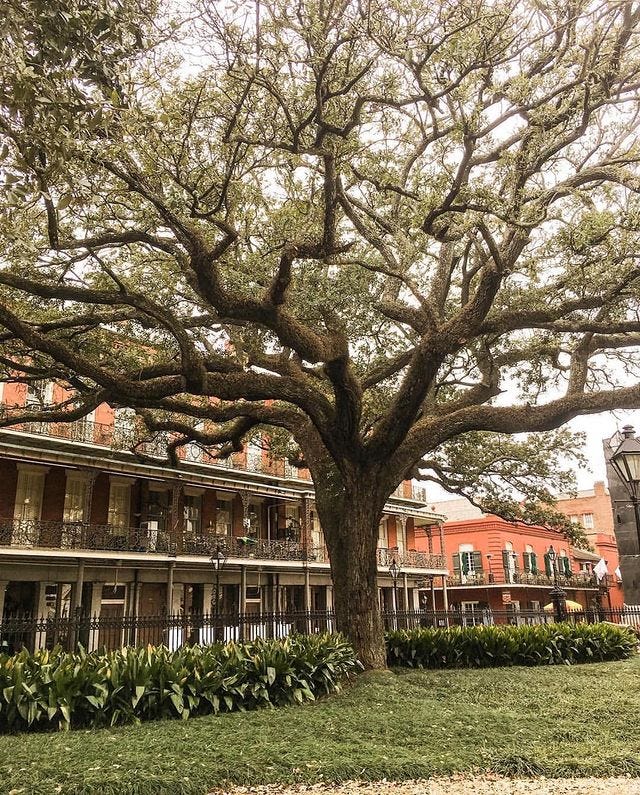
A post shared by Visit New Orleans (@visitneworleans)
Which included buildings with galleries with beautiful cast iron railings. Such as the railings on the buildings flanking St Louis Cathedral which, if you look close, have crests on them which say "AP." As in Almonester Pontalba.
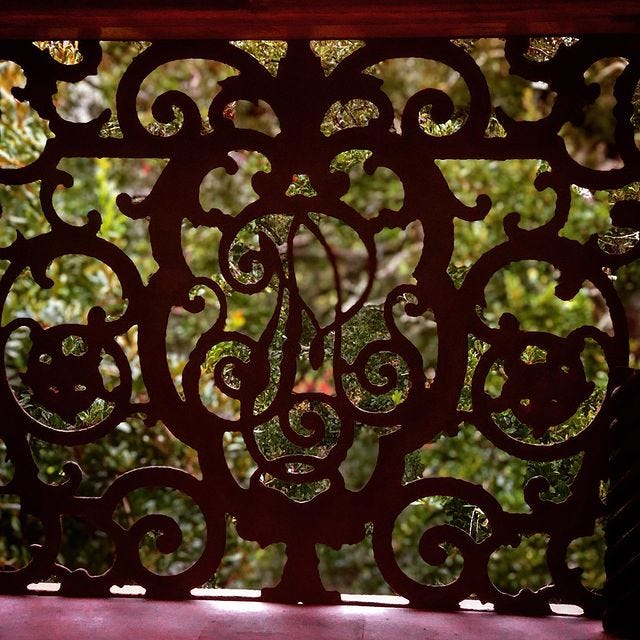
A post shared by ⚜️𝓒𝓦⚜️ (@mrcodylee)
Also the Place d'Armes became known as Jackson Square, and a statue of that same friend of hers in the White House was placed right in the middle of said square.
All those postcards centuries later, all thanks to Micaela.
Everybody wanted to be like the Baroness, so everybody else started styling their buildings like hers, beautiful iron galleries and all.
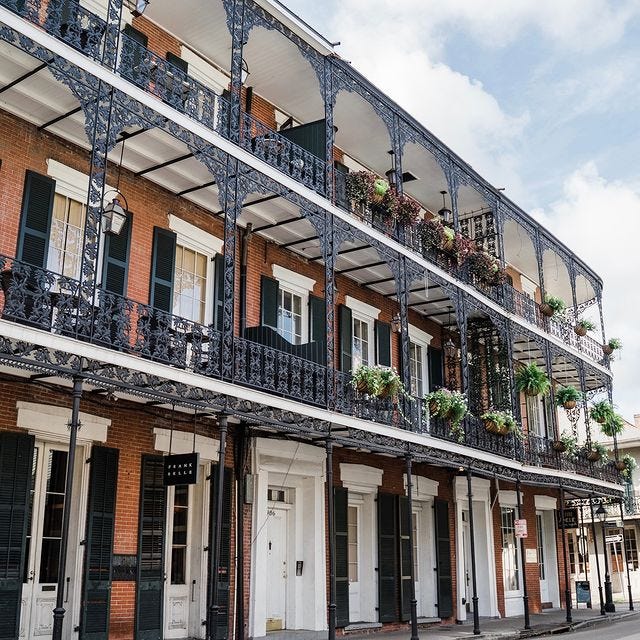
A post shared by Visit New Orleans (@visitneworleans)
And that is why the French Quarter, then city of New Orleans, looks the way that it does thanks to a single woman.
Neat, huh?
Lagniappe
Some other little details relating to Micaela that I couldn't leave out:
She hired James Gallier, a famous New Orleans architect and worthy of his own entry here, to do the work on the Pontalba buildings. For whatever reason the two of them didn't get along so she not only fired his ass but scratched out his name on the work he did for her and wrote "Nul" instead. Oh to have been a fly on the wall for those discussions if that's how they ended it.
I'm not kidding when I say Micaela was really into adding some plants. She's the reason that the spot in front of St Louis Cathedral was turned from a military parade ground (hence "Place d'Armes") into the small park that is Jackson Square. It's said that she was so passionate about tree placement she even pulled a shotgun on the mayor when he disagreed with her on the subject.
Micaela was very hands on with the project to the point where she wore pants and was constantly working at the construction site. There's a story that Andrew Jackson, upon seeing her wearing men's clothes, refused to tip his hat to her until she dressed like a proper lady.
Personally I don't believe the story because the supposed punchline is that's why the statue of Jackson in the middle of the park is tipping his hat in the direction of her apartment. It's a little too "And then everybody clapped and the teacher was Albert Einstein" yanno?
However if at least the first part of the story is true I hope Micaela's response was "How about only people who have survived being shot at four times get an opinion on my clothing? Raise your mutilated hand if that applies to you. Yeah, that's what I thought, Andy, so SHUT IT."
Other Noteworthy Stuff
Nothing else from me this week but I loved this article: With No Parades this Year, New Orleans is Festooned with Mardi Gras 'House Floats'
Though me being me I have to point out: 1) Parades do not go down Bourbon Street and 2) Red Beans and Rice is traditionally eaten the day before Mardi Gras only because Red Beans and Rice as a concept is traditionally eaten on Mondays. Mardi Gras by definition always happens on a Tuesday (that definition being "What 'Mardi' means in French") so there ya go.
(If you're curious about why Mondays, it's because historically Monday was laundry day. Laundry was a fucking long ass process before the invention of washing machines, so a dinner that could be thrown into a pot in the morning and left to cook for hours without supervision was perfect.)
Anyway, it still makes me happy to hear that people are finding a way to both have Mardi Gras and support artisans during covid, so yay for that.

